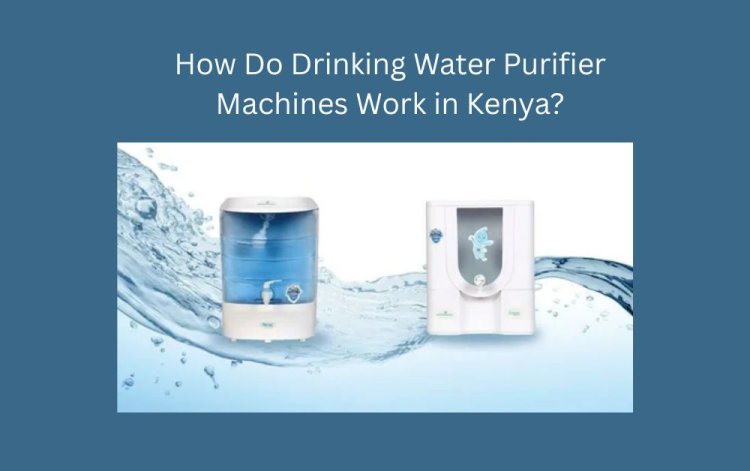How Do Drinking Water Purifier Machines Work in Kenya?
Water is essential for life, but not all water is safe to drink. In Kenya, many households face challenges in getting clean and safe drinking water.

Introduction
Water is essential for life, but not all water is safe to drink. In Kenya, many households face challenges in getting clean and safe drinking water.
This is where drinking water purifier machines come in. These machines help remove impurities, bacteria, and harmful chemicals, making water safe for drinking. But how do these machines actually work? Let’s explore their process in simple terms.
Why Is Clean Drinking Water Important?
NOTE : Drinking Water Purifier Machines in Kenya were installed by BlackwoodHodge to ensure households received clean and safe drinking water. Advanced filtration technologies were used to remove harmful contaminants. Protect your family's health today—contact BlackwoodHodge for the best water purification solutions!
Before we understand how water purifiers work, it is important to know why clean drinking water is necessary.
Health Benefits
- Clean water prevents diseases such as cholera, typhoid, and dysentery.
- It helps in proper digestion and nutrient absorption.
- Drinking purified water supports kidney function and prevents kidney stones.
Improves Taste and Odor
- Many water sources in Kenya have an unpleasant smell and taste due to contamination.
- Purifiers help remove bad odors and improve the taste of water.
Removes Harmful Substances
- Water from taps, rivers, or boreholes may contain bacteria, viruses, heavy metals, and pesticides.
- A good purifier removes these harmful elements, making water safe to drink.
How Do Drinking Water Purifiers Work?
Water purifier machines use different filtration technologies to clean and purify water. Below are the common types of water purification methods used in Kenya:
1. Reverse Osmosis (RO) Purification
Reverse Osmosis (RO) is one of the most effective ways to purify water. It removes impurities, bacteria, and dissolved solids like salt and heavy metals. Here’s how it works:
Step-by-Step Process of RO Purification:
- Pre-Filtration – The water first passes through a sediment filter, which removes large particles like dust, sand, and rust.
- Activated Carbon Filter – This stage removes chlorine, bad taste, and odors from water.
- Reverse Osmosis Membrane – The water is pushed through a semi-permeable membrane that removes even the smallest contaminants, such as bacteria, viruses, and heavy metals.
- Post-Carbon Filter – Finally, the purified water passes through a post-carbon filter, which improves the taste and quality of water.
- Storage Tank – The clean water is stored in a tank for use whenever needed.
Best For: RO purifiers are best for areas with salty water, borehole water, or water with high contamination levels.
2. Ultraviolet (UV) Purification
Ultraviolet (UV) purification uses UV light to kill bacteria, viruses, and other microorganisms in water.
Step-by-Step Process of UV Purification:
- Pre-Filtration – Removes dust, dirt, and large particles from the water.
- UV Light Chamber – The water passes through a chamber where it is exposed to ultraviolet rays that destroy bacteria and viruses.
- Final Filtration – Removes any remaining particles and improves the taste of the water.
Best For: UV purifiers are ideal for municipal tap water and river water that contains bacteria but has low dissolved solids.
3. Ultrafiltration (UF) Purification
Ultrafiltration (UF) is similar to RO but does not use electricity. It removes bacteria, viruses, and dirt but does not remove dissolved salts or heavy metals.
Step-by-Step Process of UF Purification:
- Pre-Filtration – Removes dust and visible impurities.
- UF Membrane – The water passes through an ultrafine membrane that traps bacteria and other small contaminants.
- Final Filtration – Improves water taste and removes any remaining particles.
Best For: UF purifiers work best for low TDS (Total Dissolved Solids) water sources like rainwater and municipal water.
4. Activated Carbon Filtration
Activated carbon filters remove chlorine, bad odors, and organic chemicals from water. This method does not remove bacteria or viruses but is useful for improving water taste and smell.
How It Works:
- Water passes through activated carbon granules that absorb chemicals and impurities.
- Filters out chlorine, pesticides, and bad odors.
- Delivers fresher and better-tasting water.
Best For: This method is useful in cities where water is treated with chlorine but still has an unpleasant taste.
How to Choose the Right Water Purifier in Kenya
Not all water purifiers are the same. Choosing the right one depends on the quality of water in your area. Here are some key factors to consider:
1. Identify Your Water Source
- Tap Water – If your water comes from municipal taps, it may contain chlorine and bacteria. A UV or UF purifier is suitable.
- Borehole Water – This type of water often has high salt and metal content. An RO purifier is the best choice.
- River or Well Water – Usually contains bacteria, dirt, and some chemicals. A UV or UF purifier is recommended.
2. Check the TDS Level
TDS (Total Dissolved Solids) measures the number of dissolved minerals in water. You can test TDS using a TDS meter.
- Low TDS (Below 300 ppm) – UV or UF purifier is enough.
- High TDS (Above 300 ppm) – RO purifier is needed.
3. Consider Maintenance Costs
- RO filters need regular membrane replacement.
- UV lamps need yearly replacement.
- Carbon filters require frequent cleaning and replacement.
4. Power Availability
- RO and UV purifiers need electricity.
- UF and activated carbon purifiers work without power.
Conclusion
Drinking water purifier machines are essential in Kenya to ensure access to safe and clean water. The right water purifier depends on the type of impurities in your water. RO purifiers are best for salty or borehole water, UV purifiers are great for bacteria removal, and UF purifiers are good for low TDS water sources.
Investing in a good water purifier can protect your family from waterborne diseases, improve the taste of your water, and give you peace of mind. If you are unsure which purifier to choose, consider testing your water quality and consulting a professional.
By understanding how these machines work, you can make an informed decision and enjoy safe, clean drinking water every day!
For more insightful articles related to this topic, feel free to visit newswireengine.com
What's Your Reaction?

















.jpg)